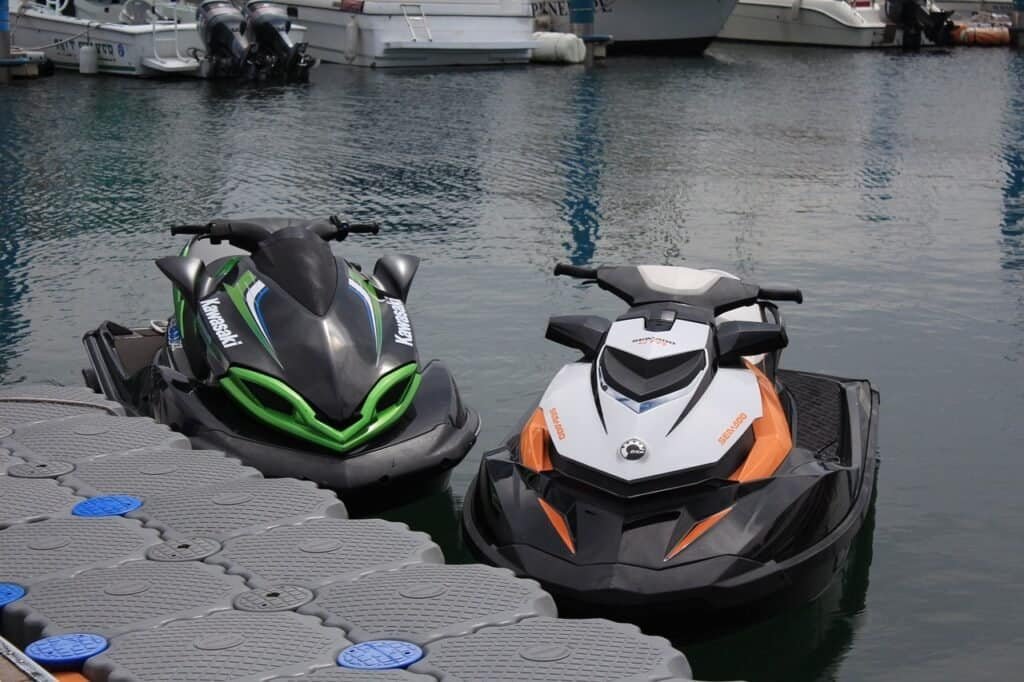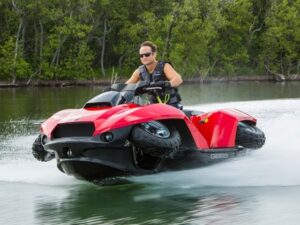This post may contain affiliate links, which means that I may make a small commission off items you purchase at no additional cost to you. Please see my terms of use page for details.
Latest Jetski Current Trends 2024
Surge in electric jetski sales: The jetski market is witnessing an unprecedented rise in electric models, driven by advancements in battery technology and increased eco-consciousness among consumers. Leading the charge is Taiga Motors with their Taiga Orca, a fully electric jetski boasting a range of up to 2 hours on a single charge and zero emissions. Additionally, Narke’s GT95 ElectroJet combines sleek design with sustainable performance, attracting buyers eager to reduce their carbon footprint.
Growing demand for personalized jetskis with custom designs: Manufacturers like Yamaha and Sea-Doo are tapping into the growing current trends of customization. Yamaha’s EX Series now replaced by the Jetblaster series offers a range of color schemes and accessory packages, while Sea-Doo’s “Build Your Own” platform allows riders to personalize everything from decals to storage solutions. The current trends in the jetski market extend to aftermarket companies offering wraps, sound systems, and upgraded seats tailored to individual preferences.
Increasing interest in family-oriented models with more seating: Family-friendly models are gaining traction as jetskiing becomes a popular group activity. The Sea-Doo GTX Limited 300, with its three-seater configuration, ample storage, and luxury features, exemplifies this trend. Kawasaki’s Jet Ski Ultra LX also stands out, offering a comfortable ride and excellent stability, perfect for families exploring lakes or coastal areas.
Powersports enthusiasts that want to merge their watercraft and 4 wheeler interests: The Gibbs Quadski stands as one of the most revolutionary products in the recreational powersports market, seamlessly blending the features of an all-terrain vehicle (ATV) and a personal watercraft (PWC).
Designed for adventurers who refuse to be limited by terrain, the Quadski can transition from land to water in less than five seconds at the push of a button. This amphibious vehicle is powered by a BMW K1300 inline-four engine, delivering up to 140 horsepower, which propels it to speeds of up to 45 mph both on land and in the water. Its hull is crafted from lightweight composite materials, ensuring durability and performance without compromising its ability to float and glide efficiently on water. The innovative retractable wheel system further enables smooth transitions, redefining what it means to explore diverse environments.
Focus on eco-conscious buyers with sustainable manufacturing practices: Brands like Taiga Motors and Narke are not only producing electric jetskis, but also adopting green production methods. Taiga uses renewable energy sources in their facilities, while Sea-Doo integrates recyclable materials into their manufacturing, reflecting a broader industry shift toward sustainability.
Spotlight on Watersports Car in Miami, FL: Watersports Car, based in sunny Miami, FL, has redefined the boundaries of recreational watercraft by blending the aesthetic and luxury of sports cars with the power and agility of high-performance jetskis. Each craft is meticulously designed with a car-like or motorcycle-like body, complete with sleek curves, vibrant color options, and automotive-inspired interiors. Powered predominantly by Yamaha’s robust 1.8L Supercharged engines, these watercraft deliver the thrilling speed and smooth handling that adrenaline-seekers crave while ensuring reliability and efficiency on the water.
Beyond their eye-catching design, Watersports Car watercraft are equipped with state-of-the-art features to enhance both performance and safety. Standard equipment includes advanced navigation systems, LED lighting for better visibility, and ergonomic seating for extended comfort. Many models also incorporate cutting-edge safety features like GPS-enabled tracking systems, onboard fire suppression, and reinforced hulls designed for durability and impact resistance. These thoughtful additions make the watercraft not just a statement piece but also a practical choice for those seeking both style and security on the waves.
For those interested in experiencing these innovative watercraft, Watersports Car offers flexible options for purchase and rental. Their showroom in Miami provides a hands-on opportunity to explore the lineup, and their website, showcases their full range of products and customization options. Rentals are also available through select marinas and luxury resorts in South Florida, giving enthusiasts the chance to test the waters before committing to ownership. Whether you’re a watersports aficionado or simply looking for a unique way to explore the coastline, Watersports Car delivers an unparalleled blend of luxury and adventure. Learn more at watersportscar.com.

Emerging Technologies In Jetskis
Introduction of autonomous navigation systems: Autonomous jetskis are no longer a distant dream. Companies like Sea-Doo are testing prototypes equipped with collision avoidance systems and autopilot capabilities, ideal for leisure cruising and rental businesses. This technology promises to enhance safety and convenience, particularly for novice riders.
Advanced GPS integration for route planning and safety: Modern jetskis, such as Yamaha’s FX Cruiser SVHO, now feature integrated GPS systems, allowing users to plan routes, track locations, and access weather updates in real-time. This advancement has made jetskis more appealing for long-distance adventures and fishing expeditions. This option is available for all Connext-equipped waverunners.
Hydrofoil jetskis offering smoother rides and energy efficiency: Hydrofoil technology is revolutionizing the industry, with models like the Lift eFoil demonstrating smoother, quieter rides with minimal energy consumption. Hydrofoil jetskis lift above the water surface, reducing drag and providing an exhilarating, efficient riding experience.
Electric Jetskis Current Trends
Improved battery technology allowing longer ride times: Recent advancements in lithium-ion batteries have extended the operating range of electric jetskis. Taiga’s Orca achieves up to 120 minutes of continuous use, while upcoming models from companies like Narke promise even longer durations.
Other players that have entered the market with affordable electric Jet Board models: The electric jetski space is becoming increasingly competitive with brands like Radinn offering more affordable entry-level jet board models such as the Radinn Freeride. This company has lowered barriers for eco-conscious buyers. Although the company has declared bankruptcy, you can still purchase leftover models at retailers or purchase a used model and experience a very unique riding experience.
Infrastructure developments, such as watercraft charging stations: Infrastructure improvements are accelerating electric jetski adoption. Companies like Aqua superPower are installing high-speed charging stations in marinas worldwide, catering to models like the Narke GT95 and Taiga Orca, ensuring riders can recharge conveniently.
Jetski Popularity Growth In 2024-2025
Rising popularity of jetskiing in inland water bodies: Jetskiing has expanded beyond coastal areas into inland lakes and rivers. Models like the Yamaha EX series and its replacement the Jetblaster series, known for its lightweight and portability, are ideal for smaller water bodies, fueling this trend.
Increased accessibility through rentals and tour packages: Rental companies are adopting family-friendly models like the Sea-Doo GTI SE 170, offering tourists an accessible way to experience jetskiing. These packages often include guided tours, boosting participation among first-time riders.
Social media influence driving interest among younger demographics: Platforms like Instagram and TikTok are showcasing exciting jetski experiences, spurring interest among younger generations. Popular models like the Sea-Doo Spark Trixx are frequently featured in social media content for their playful design and trick capabilities.

Most Popular Jetski Models 2024
Yamaha GP1800R SVHO for performance: This high-performance model is celebrated for its 1.8L supercharged engine and agile handling, making it a favorite among racers and thrill-seekers.
Sea-Doo Fish Pro for fishing enthusiasts: The Fish Pro series, equipped with a Garmin GPS fish finder, cooler, and ample storage, is the top choice for anglers seeking a specialized watercraft.
Taiga Orca Electric Jetski for eco-friendly adventurers: Combining sustainability with cutting-edge technology, the Taiga Orca is the go-to electric jetski for eco-conscious riders looking for powerful, emission-free performance.
Innovation and Technology: In The Jetski Market
Electric-Powered Jetski Innovations
Faster charging times with enhanced lithium-ion batteries: Advances in battery technology are reducing charging times significantly. Companies like Narke and Taiga Motors are developing batteries capable of reaching full charge in under an hour, making electric jetskis more practical for frequent use.
Modular battery systems for easy swapping and upgrades: Radinn’s latest models feature modular battery designs, enabling riders to swap batteries quickly or upgrade to larger capacity units for extended range. This innovation simplifies maintenance and ensures adaptability to future technological improvements.
Improved motor efficiency reducing power loss: Electric motors in jetskis are becoming more efficient, minimizing energy loss during operation. Taiga’s advanced motor systems ensure optimal performance while conserving battery life, setting new standards in electric watercraft engineering.

Autonomous Jetski Technology
Remote control options for safety and convenience: Manufacturers like Kawasaki are experimenting with remote control features, allowing owners to dock their jetskis remotely or retrieve them from the water. These features add a layer of convenience and functionality for users.
Applications in search and rescue operations: Autonomous jetskis are finding applications in emergency scenarios. Equipped with GPS and remote operation capabilities, these models can assist in search and rescue missions, delivering life-saving equipment to victims efficiently.
New Fuel-Efficient Jetski Engines
Hybrid engine models combining electric and traditional power: Hybrid engines are emerging as a bridge between traditional and electric jetskis. Yamaha’s experimental hybrid models aim to deliver the best of both worlds—electric efficiency for short rides and gas power for extended journeys.
Advanced fuel injection systems reducing emissions: Sea-Doo’s Intelligent Throttle Control (iTC) technology incorporates advanced fuel injection systems, optimizing performance while lowering emissions. This innovation aligns with global sustainability goals.
Turbocharged engines offering better performance with less fuel: Turbocharging technology is enhancing fuel efficiency without compromising power. Kawasaki’s Ultra 310 series uses turbocharged engines to achieve superior performance with reduced fuel consumption, appealing to performance enthusiasts.

Lightweight Jetski Materials 2024
Use of carbon fiber composites for durability and weight reduction: Specialty Electric jetskis like the Taiga Orca Carbon are incorporating carbon fiber hulls, reducing weight and improving maneuverability. This material also enhances durability, making jetskis more resilient to wear and tear.
Advanced polymer materials resistant to saltwater corrosion: Sea-Doo’s innovative hull designs utilize polymer composites that resist saltwater corrosion, ensuring longevity and reliability even in harsh marine environments.
Recyclable materials gaining traction for sustainability: Manufacturers like Taiga Motors are exploring recyclable materials for jetski construction, promoting environmental responsibility while maintaining high-quality standards.
Connectivity Features In Modern Jetskis: Current Trends
Integrated touchscreens for navigation, music, and diagnostics: Modern jetskis, such as the Sea-Doo GTX Limited 300, feature touchscreens that provide riders with navigation tools, music controls, and real-time diagnostics, enhancing the overall experience.
Smartphone bluetooth connectivity for audio control, incoming call, and text notifications: Yamaha’s CONNEXT screen allows riders to monitor performance metrics, fuel levels, and maintenance schedules but also allows smartphone connectivity improving convenience and usability.
Built-in Wi-Fi and Bluetooth for seamless entertainment: Jetskis like the Kawasaki Ultra LX are equipped with Bluetooth connectivity, enabling riders to stream music wirelessly while enjoying their water adventures.
Conclusion
The jetski market in 2024 is brimming with innovation and evolving consumer current trends. Electric-powered models are carving a niche with their eco-friendly appeal, while autonomous technology promises a safer and more convenient future. Lightweight materials and fuel-efficient engines address performance and environmental concerns, and connectivity features are transforming the riding experience into a tech-savvy adventure. Whether it’s the thrill of racing, the joy of family outings, or the peace of fishing on serene waters, the jetski industry continues to cater to a diverse audience. As the jetski market technology advances and accessibility improves, jetskis are set to become even more integral to water-based recreation worldwide.
Disclosure: As an Amazon Associate, I earn from qualifying purchases.
Related Articles:
Which Of The Leading Manufacturers Pioneered Significant Safety Innovations In The Jet Ski Industry?
Out Of The Top Five Jetski Brands Are There Any Significant Or Obvious Performance Differences?


